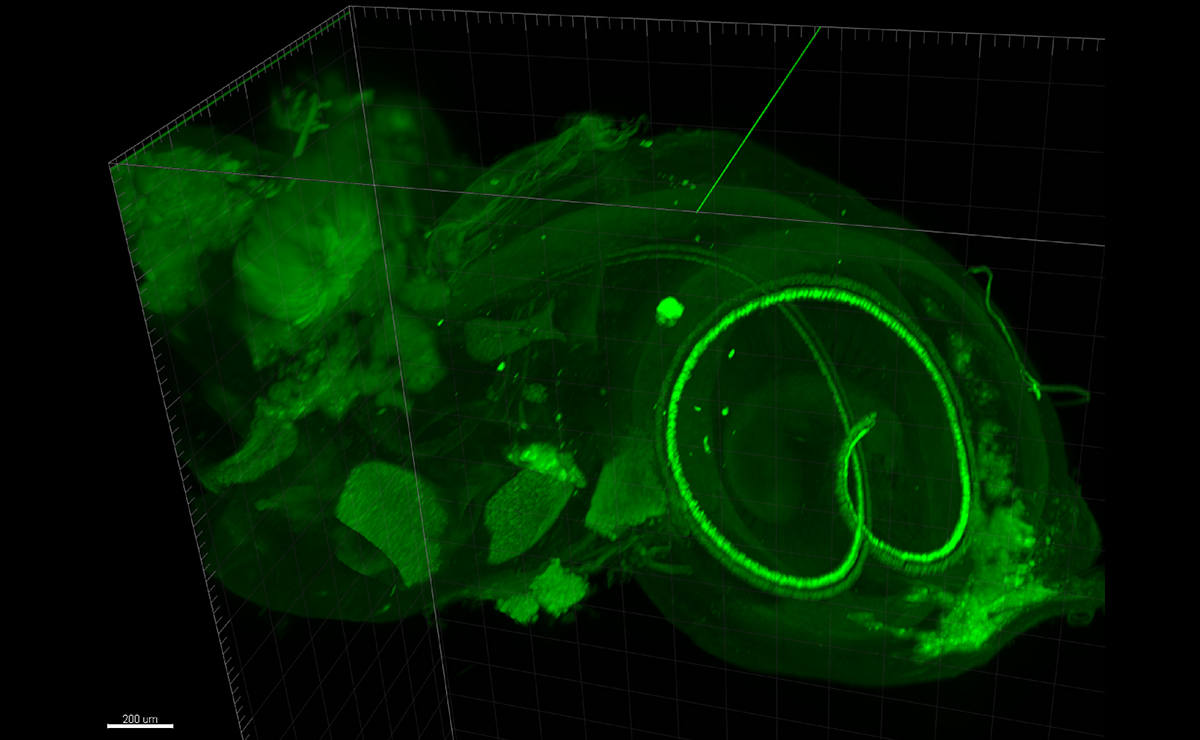A separate biomechanical pathway allows mice to communicate at high frequencies.
Like many mammals, mice can hear and communicate with sounds well outside the range audible to humans. In addition to their familiar squeaks, mice also use much higher frequency ultrasonic sounds for social communication, between mothers and pups, and during courtship or aggressive interactions.
For a long time, it was thought that animals use the same biomechanical pathways and molecules to hear ultrasonic frequencies, those higher than 20 kHz, that they use to hear lower-frequency sounds.
However, in July a team from Tsinghua showed that mice lacking a mechanosensitive ion channel found in cochlear hair cells, Piezo2, weren’t as sensitive to ultrasonic sounds, but remained sensitive to lower- frequency sounds1.
“We thus hypothesized that Piezo2 may play a role in transducing higher frequencies,” says Wei Xiong, an assistant professor in the School of Life Sciences at Tsinghua University.
Xiong and his colleagues bred knockout mice that did not express Piezo2, which is involved in the somatosensory system, in their cochlear outer hair cells for the experiment.

The researchers doubled checked that the loss of ultrasonic hearing in mice bred not to express ion channel Piezo2 in their outer hair cells was not due to a loss of hair cells at the basal coil of the cochlea by imaging mouse ears. The whole structure of the inner ear appeared intact with hair cells remaining in normal allocation and abundance in the above video, they wrote.
Ultrasonic responses
Recordings of the auditory brainstem response, measured with an electrode attached to their skull, showed that the knockout mice were significantly less sensitive to ultrasonic sounds compared with controls. In a behavioral test, in which the mice learn to freeze when they hear certain sounds, the knockout mice did not learn to freeze in response to an ultrasonic cue. This indicates that Piezo2 is essential for mice hearing ultrasonic frequencies within the range necessary for social communication. The results were published in Proceedings of the National Academy of Sciences (PNAS)2.
How, exactly, Piezo2 detects ultrasonic frequencies, and what specific part it plays in ultrasonic hearing, is not yet determined, says Xiong. It appears that Piezo2 is involved in detecting ultrasonic sounds specifically in the outer hair cells, and that it somehow coordinates with the hair-bundle mechanotransduction machinery to achieve ultrasonic transduction, but the details are still to be worked out. “These questions are exactly what we are investigating now,” he says.

Mice vocalize at frequencies higher than 25 kHz during certain social behaviors, including mother–pup interactions, male–male encounters, and male–female courtship. Mice without Piezo2 ion channels, which are mostly found in the membranes of outer cochlear hair cells, weren’t as responsive in ultrasonic behavioural tests, suggesting that this channel may be key to their ultrasonic hearing.
Understanding hearing loss
The studies demonstrate that hearing uses a more complicated set of mechanisms than was thought, says Xiong. And it raises new questions about the diversity of hearing across different species. Some animals, such as insects and frogs, lack a cochlear structure, but are still able to sense and make ultrasonic vocalizations. Whether Piezo2 is involved in their hearing needs to be examined.
This will also help understand the genetic mechanisms underlying human hearing. People gradually lose their higher-frequency hearing. Further studies of Piezo2 may shed light on the genetic basis of auditory function disorders and bring potential solutions to address age-related hearing loss.

Wei Xiong is an assistant professor in the School of Life Sciences at Tsinghua University.
References
1. Wu, Z., et al. Mechanosensory hair cells express two molecularly distinct mechanotransduction channels. Nature Neuroscience 20, 24-33 (2017) doi: https://doi.org/10.1038/nn.4449
2. Li, J. et al. PIEZO2 mediates ultrasonic hearing via cochlear outer hair cells in mice. PNAS 118, e2101207118 (2021) doi: 10.1073/pnas.2101207118

